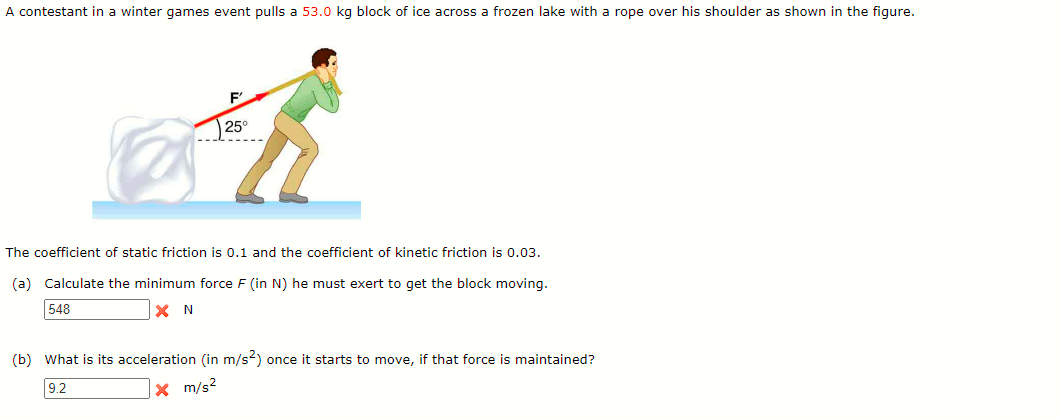A contestant in a winter games event pulls a 53.0 kg block of ice across a frozen lake with a rope over his shoulder as shown in the figure. The coefficient of static friction is 0.1 and the coefficient of kinetic friction is 0.03. (a) Calculate the minimum force F (in N) he must exert to get the block moving. ____ N (b) What is its acceleration (in m/s2) once it starts to move, if that force is maintained?
A contestant in a winter games event pulls a 53.0 kg block of ice across a frozen lake with a rope over his shoulder as shown in the figure. The coefficient of static friction is 0.1 and the coefficient of kinetic friction is 0.03. (a) Calculate the minimum force F (in N) he must exert to get the block moving. ____ N (b) What is its acceleration (in m/s2) once it starts to move, if that force is maintained?
Principles of Physics: A Calculus-Based Text
5th Edition
ISBN:9781133104261
Author:Raymond A. Serway, John W. Jewett
Publisher:Raymond A. Serway, John W. Jewett
Chapter5: More Applications Of Newton’s Laws
Section: Chapter Questions
Problem 9P: A 3.00-kg block starts from rest at the top of a 30.0 incline and slides a distance of 2.00 m down...
Related questions
Topic Video
Question
A contestant in a winter games event pulls a 53.0 kg block of ice across a frozen lake with a rope over his shoulder as shown in the figure.
The coefficient of static friction is 0.1 and the coefficient of kinetic friction is 0.03.
(a)
Calculate the minimum force F (in N) he must exert to get the block moving. ____ N
(b)
What is its acceleration (in m/s2) once it starts to move, if that force is maintained?

Transcribed Image Text:A contestant in a winter games event pulls a 53.0 kg block of ice across a frozen lake with a rope over his shoulder as shown in the figure.
25°
The coefficient of static friction is 0.1 and the coefficient of kinetic friction is 0.03.
(a) Calculate the minimum force F (in N) he must exert to get the block moving.
548
X N
(b) What is its acceleration (in m/s2) once it starts to move, if that force is maintained?
9.2
x m/s2
Expert Solution
This question has been solved!
Explore an expertly crafted, step-by-step solution for a thorough understanding of key concepts.
This is a popular solution!
Trending now
This is a popular solution!
Step by step
Solved in 4 steps

Knowledge Booster
Learn more about
Need a deep-dive on the concept behind this application? Look no further. Learn more about this topic, physics and related others by exploring similar questions and additional content below.Recommended textbooks for you

Principles of Physics: A Calculus-Based Text
Physics
ISBN:
9781133104261
Author:
Raymond A. Serway, John W. Jewett
Publisher:
Cengage Learning

Principles of Physics: A Calculus-Based Text
Physics
ISBN:
9781133104261
Author:
Raymond A. Serway, John W. Jewett
Publisher:
Cengage Learning